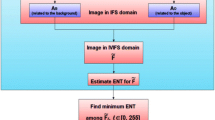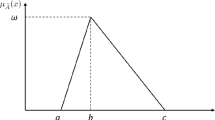Abstract
This paper presents a novel data fusion paradigm based on fuzzy evidential reasoning. A new fuzzy evidence structure model is first introduced to formulate probabilistic evidence and fuzzy evidence in a unified framework. A generalized Dempster’s rule is then utilized to combine fuzzy evidence structures associated with multiple information sources. Finally, an effective decision rule is developed to take into account uncertainty, quantified by Shannon entropy and fuzzy entropy, of probabilistic evidence and fuzzy evidence, to deal with conflict and to achieve robust decisions. To demonstrate the effectiveness of the proposed paradigm, we apply it to classifying synthetic images and segmenting multi-modality human brain MR images. It is concluded that the proposed paradigm outperforms both the traditional Dempster–Shafer evidence theory based approach and the fuzzy reasoning based approach
Similar content being viewed by others
Explore related subjects
Discover the latest articles, news and stories from top researchers in related subjects.References
Le Hegarat-Mascle S, Bloch I, Vidal-Madjar D (1997) Application of Dempster–Shafer evidence theory to unsupervised classification in multisource remote sensing. IEEE Tran Geosci Remote Sens 35:1018–1031
Le Hegarat-Mascle S, Bloch I, Vidal-Madjar D (1998) Introduction of neighborhood information in evidence theory and application to data fusion of radar and optical images with partial cloud cover. Pattern Recogn 31:1811–1823
Bloch I (1996) Some aspects of Dempster–Shafer evidence theory for classification of multi-modality medical images taking partial volume effect into account. Pattern Recogn Lett 17:905–916
Rombaut M, Zhu YM (2002) Study of Dempster–Shafer for image segmentation applications. Image Vis Comput 20:15–23
Basir OA, Shen HC (1999) Interdependence and information loss in multi-sensor system. J Robot Syst 16:597–612
Shafer G (1976) A mathematical theory of evidence. Princeton University Press, Priceton, NJ, USA
Yager T (1982) Generalized probabilities of fuzzy events from fuzzy belief structures. Inf Sci 28:45–62
Yager RR, Filev DP (1995) Including probabilistic uncertainty in fuzzy logic controller modelling using Dempster–Shafer theory. IEEE Trans SMC 25:1221–1230
Yen J (1990) Generalizing the Dempster–Shafer theory to fuzzy sets. IEEE Trans SMC 20:559–570
Denoeux T, Zouhal LM (2001) Handling possibilistic labels in pattern classification using evidential reasoning. Fuzzy Sets Syst 122:409–424
Smets P, Kennes R (1994) The transferable belief model. Artif Intell 66:191–234
Mahler RP (1995) Combining ambiguous evidence with respect to ambiguous a priori knolwedge part II: fuzzy logic. Fuzzy Sets Syst 75:319–354
Ishizuka M, Fu KS, Tao JTP (1982) Inference procedures and uncertainty for the problem-reduction method. Inf Sci 28:179–206
Ogawa H, Fu KD (1985) An inexact inference for damage assessment of existing structures. Int J Man Mach Stud 22:295–306
Binaghi E, Madella P (1999) Fuzzy Dempster–Shafer reasoning for rule-based classifiers. Int J Intell Syst 14:559–583
Dubois D, Prade H (1982) On several representations of an uncertainty body of evidence. In: Gupta MM, Sanchz E (eds). Fuzzy informaton and decision processes. North-Holland, New York, pp 167–181
Zhu H, Basir O (2003) A scheme for constructing evidence structures in Dempster–Shafer evidence theory for data fusion. In: Proceedings of the 5th IEEE international symposium on computational intelligence in robotics and automation, Japan, vol 2, pp 960–965
Basir O, Karray F, Zhu H (2005) Connectionist based Dempster–Shafer evidential reasoning for data fusion. IEEE Trans Neural Network 16:1513–1530
Shang X, Jiang W (1997) A note on fuzzy information measures. Pattern Recogn Lett 18:425–432
De Luca A, Termini S (1972) A definition of non probabilistic entropy in the setting of fuzzy set theory. Inf Control 20:301–312
Collins DL, Zijdenbos AP, Kollokian V, Sled JG, Kabani NJ, CJ Holmes, AC Evans (1998) Design and construction of a pealistic digital brain phantom. IEEE Trans Med Imaging 17:463–468
Simulated Brain Database: http://wwwbicmnimcgillca/brainweb/
Duda RO, Hart PE, Stork DG (2001) Pattern classification. Wiley, Chichester, New York
Zhu H, Basir O (2003) Feature region-merging based fuzzy rules extraction for pattern classification. In: Proceedings IEEE international conference on fuzzy systems, St. Louis, USA, pp 696–701
Author information
Authors and Affiliations
Corresponding author
Rights and permissions
About this article
Cite this article
Zhu, H., Basir, O. A novel fuzzy evidential reasoning paradigm for data fusion with applications in image processing. Soft Comput 10, 1169–1180 (2006). https://doi.org/10.1007/s00500-005-0039-1
Published:
Issue Date:
DOI: https://doi.org/10.1007/s00500-005-0039-1




